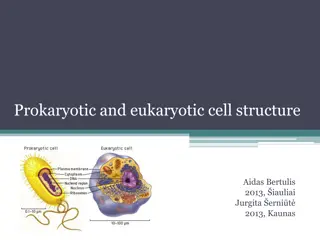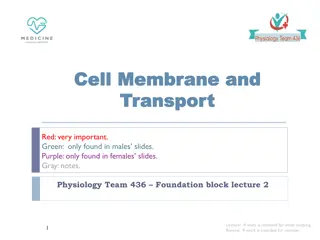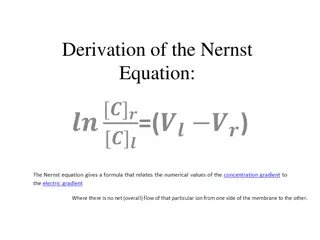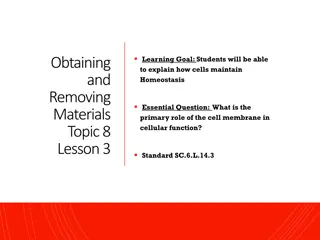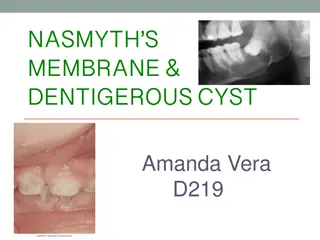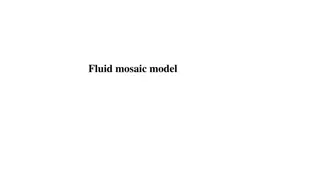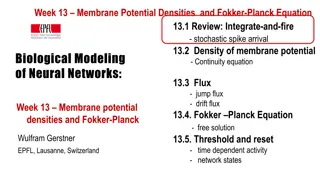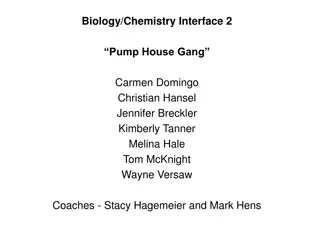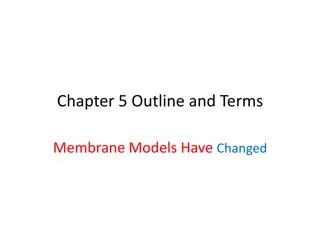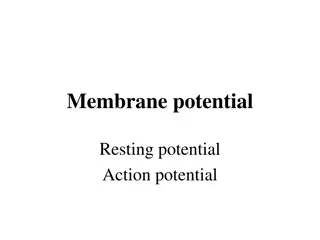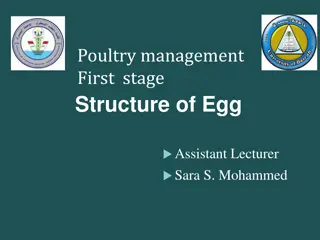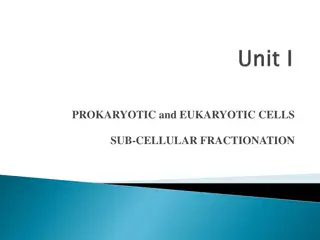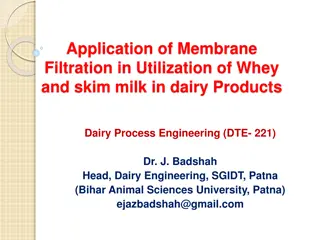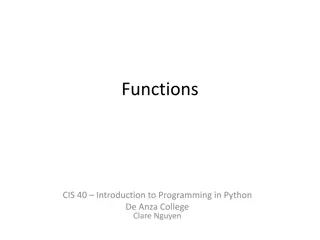Understanding Prokaryotic and Eukaryotic Cell Structure
This comprehensive guide explores the structures and characteristics of prokaryotic and eukaryotic cells. Learn about the differences and similarities between these cell types, including features like cell wall composition, membrane-bound organelles, nucleus presence, DNA structure, ribosomes, and m
7 views • 20 slides
Understanding the Cell Membrane: Structure and Function
The cell membrane is essential for life, defining cell boundaries, maintaining internal conditions, and regulating substance transport. Composed of lipids and proteins, this dynamic structure allows for selective permeability. Explore its importance in cellular processes.
4 views • 30 slides
If you are looking for Old Roof Replacements in Sydenham
If you are looking for Old Roof Replacements in Sydenham, Welcome to Specialised Roofing Systems in Kennedys Bush. We are the experts in all membrane roofing solutions. Our team is Experienced & Qualified including a National Certificate in Membrane Roofing and Torch-On Roofing. Our small but passio
0 views • 6 slides
Understanding Resting Membrane Potential and Excitability in Cells
Explore the concepts of resting membrane potential (RMP), excitability in cells, and the electrochemical basis behind them. Learn about the characteristics of excitable and non-excitable tissues, the factors influencing RMP, and the role of ion distribution in generating the negative charge inside c
0 views • 15 slides
Understanding Movement of Substances Through Cell Membrane
Substances enter and leave cells through diffusion and osmosis processes, driven by concentration gradients. The cell membrane plays a crucial role in selectively allowing substances to pass, ensuring cell survival. Osmosis can be demonstrated using Visking tubing, showing water molecules moving whi
0 views • 15 slides
Understanding Active Transport: Energy-Driven Cellular Processes
Active transport is a vital process in cells that require energy in the form of ATP to move materials across the plasma membrane against their concentration gradient. This process involves pumps, endocytosis, and exocytosis. The sodium-potassium pump in nerve cells is a classic example of active tra
0 views • 9 slides
Understanding Cell Membrane Transport: Diffusion and Facilitated Diffusion
Cell membrane transport plays a crucial role in maintaining cellular functions by regulating the movement of substances across the membrane. Diffusion, a passive transport process, allows molecules to move from areas of high concentration to low concentration without energy expenditure. Within diffu
2 views • 20 slides
Bacterial Cell Structure and Composition Overview
Bacterial cells exhibit variations in size, typically ranging from 0.75 to 1.5 micrometers. The cell envelope, comprising glycocalyx, cell wall, and cell membrane, plays crucial roles in protection and cell function. The cell membrane, a thin barrier rich in phospholipids and proteins, is integral t
1 views • 28 slides
Livestock Marketing Functions and Classification
Livestock marketing involves various functions such as exchange, physical supply, facilitative functions like grading, transportation, storage, and more. These functions are classified into primary, secondary, and tertiary functions based on their roles. Assembling, processing, distribution, and equ
3 views • 23 slides
Understanding Cellular Transport and the Role of Cell Membrane
Explore the process of cellular transport, where materials are exchanged between organisms and their environments. Discover the types of materials transported into and out of cells, from water to waste materials. Delve into the significance of the cell membrane as the final point of transfer and its
0 views • 61 slides
Understanding Membrane Proteins and Cell Membrane Permeability
Cell membranes consist of phospholipid bilayers with embedded proteins, including integral and peripheral proteins. Integral proteins span the membrane, while peripheral proteins interact with the surface. Only non-polar molecules can pass through the membrane directly, while charged ions, polar mol
0 views • 30 slides
Understanding Cell Membrane Structure and Function
This educational content delves into the structure and function of the cell membrane, covering topics such as the fluid mosaic model, permeability, carrier-mediated processes, and membrane proteins. It explains the composition of the cell membrane, selective permeability, and the roles of integral a
0 views • 36 slides
Comprehensive Overview of Treatment Membranes in Water Quality Risk Assessment Training
Comprehensive overview of treatment membranes in water quality risk assessment training, covering various membrane types, applications, and considerations. Membranes play a crucial role in removing a range of contaminants from water sources, with different membrane types suited for specific applicat
0 views • 9 slides
Overview of Treatment with Reverse Osmosis (Desalination)
Reverse osmosis (RO) is a treatment method used in challenging water treatment situations to remove contaminants effectively. It requires pre-treatment and remineralization, making it suitable for mineral and chemical contamination. RO systems need careful maintenance to prevent fouling and membrane
0 views • 6 slides
Understanding the Derivation of the Nernst Equation and Its Implications
The Nernst Equation is derived to provide insight into membrane potential and its role in various health conditions like cystic fibrosis and epilepsy. This derivation involves combining diffusive flux, electric drift, and mobility terms, leading to a deeper understanding of membrane behavior. The Bo
2 views • 26 slides
Understanding Cell Membrane: Maintaining Homeostasis in Cells
Cells maintain homeostasis to function effectively. The cell membrane plays a crucial role in this process by regulating material exchange, separating the cell from its environment, and ensuring internal balance. Understanding how cells exchange materials through the membrane is key to comprehending
1 views • 16 slides
Understanding Nasmyth's Membrane and Dentigerous Cysts in Dental Health
Nasmyth's Membrane is a residue found on newly erupted teeth, causing extrinsic staining. It can be treated with selective polishing and proper brushing. Dentigerous cysts, odontogenic cysts associated with developing teeth, may lead to dental issues. Treatment for cysts includes monitoring and, if
0 views • 9 slides
Understanding Functions in Python: Basics and Usage
In this lecture on functions in Python, the focus is on the basics of defining and using functions. The session covers the formal definition of functions, parameters, local and global scopes of variables, return values, and pass-by-value concept. It emphasizes the importance of proper indentation in
1 views • 28 slides
Mechanisms of Nutrient Uptake by Microbial Cells
Nutrient uptake by microbial cells involves various transport mechanisms such as passive diffusion, facilitated diffusion, active transport, and group translocation. These mechanisms ensure the specific acquisition of required nutrients by the cell through the selectively permeable plasma membrane.
3 views • 15 slides
Understanding Functions: Tables, Graphs, and Formulas Based on Functions, Data, and Models
Explore the world of functions through tables, graphs, and formulas in this presentation based on the book "Functions, Data, and Models" by S.P. Gordon and F.S. Gordon. Learn how functions in the real world work, understand the relationship between variables, and see different representations of fun
0 views • 29 slides
Understanding Membrane Treatment in Water Filtration Systems
Membrane treatment plays a crucial role in water filtration systems by removing various contaminants such as turbidity, microbiology, and chemical impurities. This overview covers different types of membranes like plate and frame, spiral wound, tubular, and hollow fiber, highlighting their functions
0 views • 9 slides
Understanding SQL Functions for Database Queries
SQL functions are essential elements in performing actions and obtaining results in a database query. They come in two main types: scalar functions and aggregate functions. Scalar functions operate on single values, while aggregate functions operate on sets of data. Examples of SQL functions include
0 views • 14 slides
Understanding Bacterial Cell Structure and Function
Bacteria display unique cellular structures and functions that differ from eukaryotic cells. They have a simple structure with a plasma membrane but lack complex internal membrane systems. The cytoplasm contains inclusion bodies, ribosomes, and genetic material in the nucleoid. Bacteria can be categ
4 views • 21 slides
Understanding the Fluid Mosaic Model of Plasma Membrane Structure
The fluid mosaic model proposed by S.J. Singer and Garth L. Nicolson describes the structure of the plasma membrane as a fluid combination of phospholipids, cholesterol, proteins, and carbohydrates. This model explains how phospholipids form a stable barrier, the role of saturated and unsaturated fa
2 views • 6 slides
Exploring Membrane Potential Densities and the Fokker-Planck Equation in Neural Networks
Delve into the concepts of membrane potential densities and the Fokker-Planck Equation in neural networks, covering topics such as integrate-and-fire with stochastic spike arrival, continuity equation for membrane potential density, jump and drift flux, and the intriguing Fokker-Planck Equation.
0 views • 29 slides
Understanding Cellular Membrane Transport in Biology/Chemistry Interface 2
Explore the teachable unit on membrane transport in an introductory biology class for majors to understand how cells exchange substances with their environment. The unit covers selective membrane permeability, membrane transport mechanisms, proteins involved, physiological importance, and outcomes o
0 views • 23 slides
Evolution of Membrane Models: From Early Observations to Fluid-Mosaic Structure
Researchers in the early 20th century noted the permeability of lipid-soluble molecules into cells, paving the way for membrane studies. The development of membrane models progressed from the sandwich model to the widely accepted fluid-mosaic model. The complexity of the plasma membrane, comprising
0 views • 22 slides
Understanding Membrane Potential and Action Potentials in Excitable Cells
Membrane potential, resting potential, and action potentials play crucial roles in the functioning of excitable cells like neurons, muscle cells, and endocrine cells. Voltage-gated channels, depolarization, and repolarization are key processes involved in generating and propagating action potentials
0 views • 26 slides
Understanding Membrane Transport in Plant Cells
Plant cells rely on membrane transport to facilitate the movement of molecules across their plasma membrane. This process involves passive and active transport mechanisms, with the help of specialized proteins such as channels, carriers, and pumps. Channels serve as selective pores for ions and wate
0 views • 20 slides
Comparison of Eukaryotic and Prokaryotic Cells in Cell Biology
Cells are the fundamental units of life, but viruses are an exception as they lack cells. Eukaryotic cells have a defined nucleus with a nuclear membrane housing chromosomes, while prokaryotic cells lack a membrane-bound nucleus and other organelles. Eukaryotic cells are larger, containing membrane-
0 views • 9 slides
Understanding the Structure of Eggs in Poultry Management
Eggs in poultry management consist of the yolk, albumen, shell membrane, and shell. The yolk is the yellow center surrounded by the vitelline membrane. The albumen makes up most of the egg and has two layers - outer thin white and inner thick white with chalazae. The shell membrane and shell protect
0 views • 14 slides
Understanding Biomembranes: Composition, Structure, and Functions
Biomembranes, specifically the plasma membrane, play a crucial role in cell function by separating and protecting the cell, facilitating communication with the environment, and regulating transport processes. Composed of lipids, proteins, and carbohydrates, membranes have a fluid mosaic structure wi
0 views • 13 slides
Understanding Composition of Functions in Mathematics
Learn how to perform operations with functions, find composite functions, and iterate functions using real numbers. Explore the composition of functions through examples and understand the domain of composite functions. Enhance your mathematical skills by mastering operations like addition, subtract
0 views • 10 slides
Understanding Functions in C Programming
Functions play a vital role in C programming by enabling the execution of specific tasks. They can be pre-defined or user-defined, offering flexibility and efficiency in code organization and execution. Pre-defined functions are already available in C libraries, while user-defined functions are cust
0 views • 46 slides
Understanding Functions in Computer Science I for Majors Lecture 10
Expanding on the importance of functions in programming, this lecture delves into dividing code into smaller, specific pieces, defining functions in Python, understanding function calls and parameter passing, and using functions to enhance code modularity. Key topics covered include control structur
0 views • 62 slides
Prokaryotic and Eukaryotic Cells: A Comparative Overview
Prokaryotic cells are simpler and lack membrane-bound organelles, reproducing through binary fission. Eukaryotic cells are more complex, larger, with a nucleus enclosed in a nuclear envelope. They have various organelles and a cell wall. The plasma membrane defines cell boundaries, regulating the pa
0 views • 13 slides
Membrane Filtration in Dairy Products: Utilization of Whey and Skim Milk
Utilizing membrane filtration in dairy processing transforms whey, a byproduct of cheese production, into valuable products like refined proteins. Ultrafiltration (UF) allows for the fractionation of whey into protein-rich and lactose-containing streams, increasing protein content significantly. The
0 views • 11 slides
Understanding Closures, Lambda Functions, and Higher-Order Functions in Programming
In programming, closures bind functions and lexical environments, while lambda functions are nameless and used by higher-order functions. Higher-order functions operate by applying other functions, such as map and fold functions. Example implementations in LISP demonstrate how these concepts are uti
1 views • 16 slides
Introduction to Python Functions: Overview and Usage
In this module, we delve into Python functions, exploring common built-in functions and how to create custom functions. We learn the properties of functions, how to coordinate multiple functions, and concepts of modularization. Discover the essence of functions in Python programming through practica
0 views • 17 slides
Understanding the Composition and Function of the Plasma Membrane in Animal Cells
The plasma membrane is a vital component of animal cells, serving as a barrier that regulates the passage of substances. Composed mainly of lipids and proteins, it plays a crucial role in cell structure and function. This article explores the chemical composition, molecular structure, and significan
0 views • 16 slides
